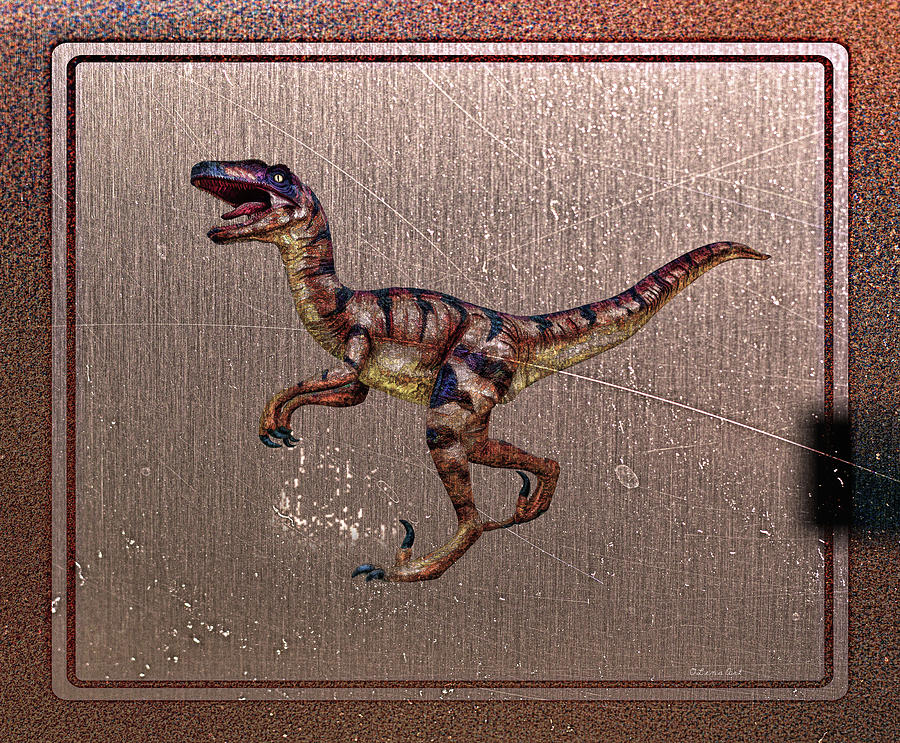
T. Rex

by Lena Owens - OLena Art Vibrant Palette Knife and Graphic Design
Title
T. Rex
Artist
Lena Owens - OLena Art Vibrant Palette Knife and Graphic Design
Medium
Digital Art - Digital
Description
inspired by Jurassic Park and Dinosaurs of course :) Tyrannosaurus is a genus of coelurosaurian theropod dinosaur. The species Tyrannosaurus rex, is one of the most well-represented of the large theropods. Wikipedia
Scientific name: Tyrannosaurus
Speed: Tyrannosaurus rex: 25 mph
Higher classification: Tyrannosaurini
Rank: Genus
Earliest fossil record: Cretaceous
Did you know: T Rex's head was over 1.25 m (4.1 ft.) long.
T. rex was a huge meat-eating dinosaur that lived during the late Cretaceous period, about 85 million to 65 million years ago. T. rex lived in a humid, semi-tropical environment, in open forests with nearby rivers and in coastal forested swamps. The seasons were mild.
Until recently, Tyrannosaurus rex was the biggest known carnivorous dinosaur; Giganotosaurus and Carcharodontosaurus are slightly bigger.
ANATOMY
Tyrannosaurus rex was a fierce predator that walked on two powerful legs. This meat-eater had a huge head with large, pointed, replaceable teeth and well-developed jaw muscles. It had tiny arms, each with two fingers. Each bird-like foot had three large toes, all equipped with claws (plus a little dewclaw on a tiny, vestigial fourth toe). T. rex had a slim, stiff, pointed tail that provided balance and allowed quick turns while running. T. rex's neck was short and muscular. Its body was solidly built but its bones were hollow.
SIZE
Tyrannosaurus rex was up to 40 feet (12.4 m) long, about 15 to 20 feet (4.6 to 6 m) tall. The arms were only about 3 feet (1 m) long. Tyrannosaurus rex was roughly 5 to 7 tons in weight.
The enormous skull was about 5 feet (1.5 m) long. The eye sockets in the skull are 4 inches (10.2 cm) across; the eyeballs would have been about 3 inches (7.6 cm) in diameter.
T. rex left footprints 1.55 feet (46 cm) long (although its feet were much longer, about 3.3 feet (1 m) long; T. rex, like other dinosaurs, walked on its toes). It had a stride length of up to 12 to 15 feet (3.7-4.6 m). T. rex may have run at up to 15 mph (24 kph).
TEETH AND JAWS
T. rex skull
T. rex's jaws were up to 4 feet (1.2 m) long and had 50 to 60 thick, conical, bone-crunching teeth that ranged in size from very small to over 9 inches (23 cm) long. Adult had a variety of sizes of teeth in their jaws at one time, as teeth were broken and new (smaller) ones grew in to replace them. One T. rex was found with some teeth up to 13 inch (33 cm) long. T. rex could eat up to 500 pounds (230 kg) of meat and bones in one bite!
Tyrannosaurus rex had a wrap-around overbite; when T. rex closed its mouth, the upper parts of the lower jaw's teeth fit inside the upper teeth.
SKIN
Fossilized specimens of T. rex's rough, scaly skin have been found. It was bumpy, like an alligator's skin, and has been described as a "lightly pebbled skin."
HABITAT AND DISTRIBUTION
Tyrannosaurus rex probably lived in forests, where its prey (plant-eating dinosaurs) could find plenty of food. T. rex fossils have been found in western North America and Mongolia.
SENSES
Sight: T. rex had large visual lobes in its brain that processed visual information. T. rex also had depth perception (since both eyes faced forwards on the front of its skull, and not placed on the sides), but it was not the only dinosaur that had depth perception. In general, predators (hunters) ofter have depth perception to help them hunt their prey. Animals that are hunted (like the plant-eating dinosaurs) usually have eyes located on the sides of their head (having no depth perception); this lets them see predators approaching from both sides.
Smell: T. rex's brain had a very large area in the brain for processing odors.
TAIL
Tyrannosaurus had a stiff, pointed tail (like other Tetanurans [meaning "stiff tail"]). The tail was used as a counterbalance for its enormous head, for agility and for making quick turns.
The rear part of the tail was stiffened by interlocking vertebral zygopophyses (interlocking bony structures projecting forwards and backwards from the neural arches, interlocking one vertebra into another).
drawing, draw, drawn, illustration, illustrate, illustrating art, artwork, artist ink, sketch, line form, animal art, baby, background, big cartoon, colorful creature, dangerous, design, dino, dinosaur, dinosaurs, drawing, extinct, fossil, funny, illustration, isolated, jurassic dinosaur, dino, t rex, prehistoric, beast, jurassic park, lightning, metal frame,
Uploaded
May 28th, 2017
Statistics
Viewed 4,187 Times - Last Visitor from New York, NY on 04/24/2024 at 12:02 PM
Embed
Share
Sales Sheet




























































